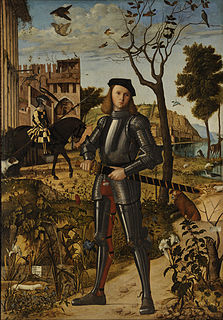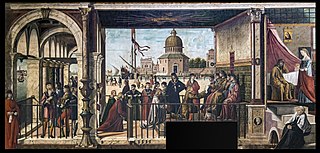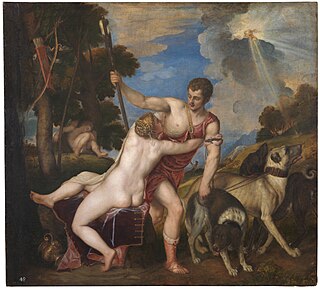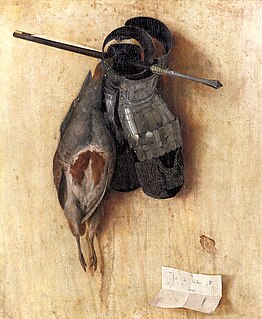
The Doge's Palace is a palace built in Venetian Gothic style, and one of the main landmarks of the city of Venice in northern Italy. The palace was the residence of the Doge of Venice, the supreme authority of the former Republic. It was built in 1340 and extended and modified in the following centuries. It became a museum in 1923 and is one of the 11 museums run by the Fondazione Musei Civici di Venezia.

Vittore Carpaccio was an Italian painter of the Venetian school, who studied under Gentile Bellini. He is best known for a cycle of nine paintings, The Legend of Saint Ursula. His style was somewhat conservative, showing little influence from the Humanist trends that transformed Italian Renaissance painting during his lifetime. He was influenced by the style of Antonello da Messina and Early Netherlandish art. For this reason, and also because so much of his best work remains in Venice, his art has been rather neglected by comparison with other Venetian contemporaries, such as Giovanni Bellini or Giorgione.

Pisanello, born Antonio di Puccio Pisano or Antonio di Puccio da Cereto, also erroneously called Vittore Pisano by Giorgio Vasari, was one of the most distinguished painters of the early Italian Renaissance and Quattrocento. He was acclaimed by poets such as Guarino da Verona and praised by humanists of his time, who compared him to such illustrious names as Cimabue, Phidias and Praxiteles.

The Museo Correr is a museum in Venice, northern Italy. Located in St. Mark's Square, Venice, it is one of the 11 civic museums run by the Fondazione Musei Civici di Venezia. The museum extends along the southside of the square on the upper floors of the Procuratorie Nuove. With its rich and varied collections, the Museo Correr covers both the art and history of Venice.

The Musée Jacquemart-André is a private museum located at 158 Boulevard Haussmann in the 8th arrondissement of Paris. The museum was created from the private home of Édouard André (1833–1894) and Nélie Jacquemart (1841–1912) to display the art they collected during their lives.

Michele Taddeo di Giovanni Bono, known as Giambono was an Italian painter, whose work reflected the International Gothic style with a Venetian influence. He designed the mosaics of the Birth of the Virgin and Presentation in the Temple. His best known paintings are the Man of Sorrows and the St. Peter.

Lazzaro Bastiani was an Italian painter of the Renaissance, active mainly in Venice.

Young Knight in a Landscape, or Portrait of a Knight, is an oil on canvas painting by the Italian Renaissance artist Vittore Carpaccio, now in the Thyssen-Bornemisza Collection in Madrid. Dated 1510, this is the earliest full-length portrait in Western painting—on the assumption that it is a portrait, as it seems likely. It is characteristic of Carpaccio that apart from this important innovation, the style of the work seems in other respects to look back to the previous century. From some time until the 20th century the painting had been given the monogram of Albrecht Dürer, and Carpaccio's signature had been overpainted. The realism and detail of Carpaccio does in fact show Northern influence.

Venetian painting was a major force in Italian Renaissance painting and beyond. Beginning with the work of Giovanni Bellini and his brother Gentile Bellini and their workshops, the major artists of the Venetian school included Giorgione, Titian, Tintoretto (1518–1594), Paolo Veronese (1528–1588) and Jacopo Bassano (1510–1592) and his sons. Considered to give primacy of colour over line, the tradition of the Venetian school contrasted with the Mannerism prevalent in the rest of Italy. The Venetian style exerted great influence upon the subsequent development of Western painting.

The Legend of Saint Ursula is a series of large wall-paintings on canvas by the Italian Renaissance artist Vittore Carpaccio, originally created for the Scuola di Sant'Orsola (Ursula) in Venice. They are now in the Gallerie dell'Accademia in Venice.

A composition of Venus and Adonis by the Venetian Renaissance artist Titian has been painted a number of times, by Titian himself, by his studio assistants and by others. In all there are some thirty versions that may date from the 16th century, the nudity of Venus undoubtedly accounting for this popularity. It is unclear which of the surviving versions, if any, is the original or prime version, and a matter of debate how much involvement Titian himself had with surviving versions. There is a precise date for only one version, that in the Prado in Madrid, which is documented in correspondence between Titian and Philip II of Spain in 1554. However, this appears to be a later repetition of a composition first painted a considerable time earlier, possibly as early as the 1520s.

The Christ between Four Angels and the Instruments of the Passion is a painting by the Italian Renaissance master Vittore Carpaccio, executed in 1496 and now housed in the Civici musei e gallerie di storia e arte of Udine, northern Italy.

St. Augustine in His Study is a tempera on panel painting by the Italian Renaissance artist Vittore Carpaccio housed in the Scuola di San Giorgio degli Schiavoni of Venice, northern Italy.

The Scuola di San Giorgio degli Schiavoni in Venice, northern Italy, was one of the city's confraternities, a scuola piccola. Its building has been preserved.

The Sermon of Saint Stephen is an oil-on-canvas by Italian artist of the Venetian school Vittore Carpaccio, painted in 1514. It is now in the Louvre in Paris.
Giovanni Spoldi was an Italian painter, active mainly in the Veneto, painting vedute of marine scenes.

The Zadar Polyptych is an oil-on-panel by Italian artist Vittore Carpaccio, painted around 1480–1490. It is now in the Museum of Sacred Art of the Zadar Cathedral, in southern Croatia. It was commissioned by Martin Mladošić, canon, notary and archpresbyter of Nin from Zadar, for the altar of St. Martin in Zadar Cathedral.

The Pardo Venus is a painting by the Venetian artist Titian, completed in 1551 and now in the Louvre Museum. It is also known as Jupiter and Antiope, since it seems to show the story of Jupiter and Antiope from Book VI of the Metamorphoses. It is Titian's largest mythological painting, and was the first major mythological painting produced by the artist for Philip II of Spain. It was long kept in the Royal Palace of El Pardo near Madrid, hence its usual name; whether Venus is actually represented is uncertain. It later belonged to the English and French royal collections.

The Adoration of the Shepherds by Giovanni Cariani is a panel painting of about 1515-1517, now in the Royal Collection of the United Kingdom. The painting is somewhat damaged, and also seems to have been subject to significant changes of intention during the process of painting. It was one of the large group of paintings bought by Charles I of England from the collection of Vincenzo II, last of the Gonzaga Dukes of Mantua in 1628. The painted surface measures 73.6 cm × 120.3 cm.

Still-Life with Partridge and Gauntlets is a 1504 painting by the Italian painter Jacopo de' Barbari. It measures 52 cm × 42.5 cm and is held by the Alte Pinakothek in Munich. The small oil-on-limewood-panel painting is considered to be one of the earliest examples of a still life painting, and one of the first trompe-l'œil paintings, to be made in Europe since classical antiquity.




















